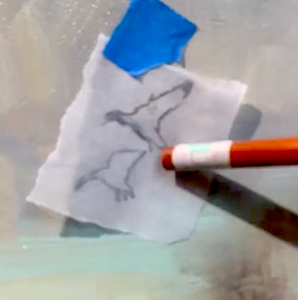You might enjoy this helpful trick for drawing and painting small details which really works!
It might kind of feel like cheating, but it isn’t. It’s just a shortcut. I borrowed this tracing paper trick from my encaustic painting techniques and tried it out on this oil painting and it worked!
Read on to see how to try it drawing and painting yourself. Be sure to scroll down to the bottom of this post to see my Instagram video which shows you how!

Here’s the backstory
Recently, I was commissioned to create a duck-hunting oil painting.
It was a challenging commission for me. My client was very specific about what he wanted, for example… his recognizable Illinois duck blind and pond, blue skies, puffy white clouds, decoys to the left of the blind, the wind and water blowing from the left, mallard ducks landing from the right, and all in a 30×20 vertical format! 😅
Drawing and painting tiny details, especially in oil can be difficult. That’s why this tracing paper shortcut really helped. It made it much easier for me decide upon the placement of the flying ducks.
Here’s how it works
I drew the duck shapes ‘backwards ‘ onto a piece of tracing paper using a sharp charcoal pencil. Once I had a good design, I transferred the charcoal drawing onto the painting.

However, the painting needed to be almost dry to the touch for this to work. I used Cobra water-mixable oils and my favorite Quick Dry medium which really helped speed up the drying. It was dry to the touch in about 2-3 days.
Once the drawing was successfully transferred to the painting, I of course had to paint the ducks to give them life.
The second clip in the following video shows how I used “massing-in” to form the duck shapes. I then painted around the negative space to refine the shape of the ducks – and voilà! Lucky for me, my collector loved it!!
You can see the finished painting on my site, www.LoriMcNee.com.
View this post on InstagramA post shared by LORI MCNEE 🎨 (@lorimcneeartist) on










